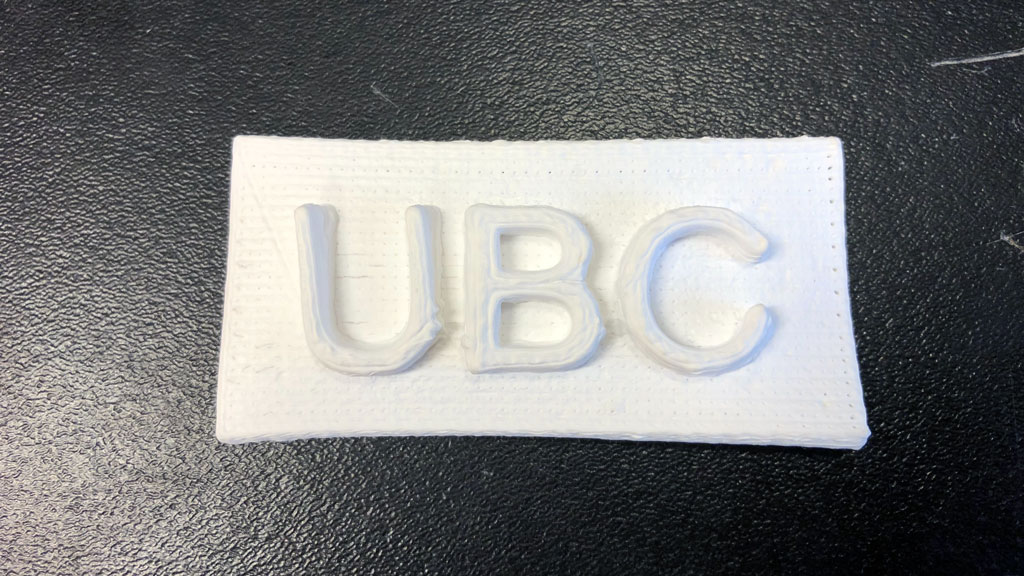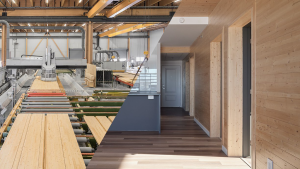At the University of British Columbia (UBC), researchers are combining science and robotics to develop new and creative uses for wood and cellulose.
UBC’s Centre for Advanced Wood Processing (CAWP) has been investigating how robotics can be used in wood processing.
“Robots are being used more and more often in wood processing,” said CAWP managing director Jason Chiu. “For example, five-axis CNC (Computer Numerical Control) machinery is being used for many repetitive tasks in the sector, as well as for sanding, spraying and finishing.”
Robots, such as CAWP’s eight-axis machine that is mounted on a track and turntable, can also be used for milling.
Because milling, which requires a series of different cuts, is not a repetitive process, the robots need complex programming.
CAWP put the eight-axis machine through its paces in June when it hosted a week-long workshop to demonstrate the nuts and bolts of robotic wood milling.
We have developed a 3D printing technology…that uses cellulose fibres to produce 3D objects,
— Feng Jiang
University of British Columbia
A segment of the workshop got participants to design and build a full-scale plywood prototype.
They used the robot to custom-mill sheets of plywood into various sizes and forms and then assemble them onsite.
The final product of the participants’ efforts was given a spot on UBC’s Vancouver campus so people passing by could look at it.
Chiu said CAWP was founded in the 1990s to provide training, research and professional development outreach to the Canadian value-added wood products industry.
There is growing support for a transition to a value-added industry which uses such technologies as robotics in order to foster job creation and encourage sustainable forest development.
“But there is a lack here of a workforce with the right knowledge and skills to develop and apply the technologies that are needed to sustain our competitive position,” Chiu said. “In the past, the sector brought in its expertise from abroad. Now Canada wants to grow its own experts.”
CAWP is a UBC interdisciplinary initiative that is administered by, among others, the Faculty of Forestry.
There, researchers are developing a bioproduct filament that can be used in the laser heads of 3D printers for additive manufacturing.
“We have developed a 3D printing technology – a high-resolution computer-aided design and fabrication technology – that uses cellulose fibres to produce 3D objects,” said Feng Jiang assistant forestry professor and Canada Research Chair in Sustainable Functional Biomaterials.
Jiang said 3D printing can create very complex, customized objects.
“The technology has been used for such materials as polymers, metals, ceramics and cement,” he said. “However, its application to bio-based polymers, especially cellulose, has been limited.”
One of the reasons for its limited use is that cellulose is hard to process.
“For example, it can’t be melt-processed or easily dissolved in green solvents,” said Jiang.
To address these challenges, UBC researchers have developed a water-based cellulose ink that can be 3D-printed into various shapes.
“There are millions of cellulose nano-fibrils bundled together in a single cellulose fibre that can be found in paper or tissue,” he said.
Jiang and his associates have used this technology to print a lightweight honeycomb structure with some unique properties.
“Nature has created numerous smart and sophisticated designs, from butterfly wings to beetle shells, that reflect millions of years of evolution,” he said.
The honeycomb structure created in Jiang’s lab is light enough to stand on top of a dandelion, but also strong enough to withstand over 15,000 times its own weight (such as the weight of a kettle ball) on top of it.
“When wet, this structure also demonstrates superior flexibility,” said Jiang. “It can be bent, rolled and twisted in all directions.”
It’s possible, he said, that a cellulose honeycomb structure of this kind could be used in the future as a lightweight structural component, thermal insulation layer or for various consumer products.
“The primary objective of my research program is to convert naturally abundant biomass into functional biomaterials, to create alternative sources of useful materials,” said Jiang. “We are seeing the range of forest products expand beyond conventional wood, pulp and paper products to include high-performance cellulose-based materials.
“My lab is focused on the latter. We design high-performance materials by mimicking nature’s processes and using simple and abundantly available elements and materials.”





Recent Comments